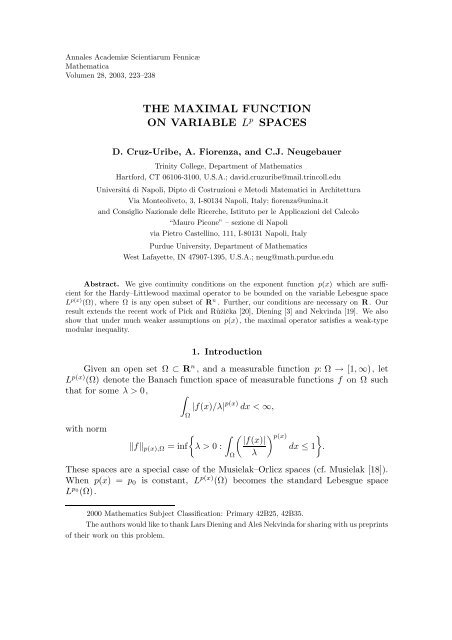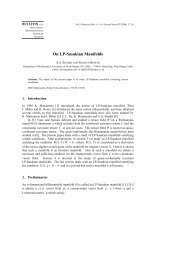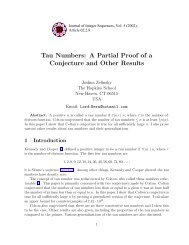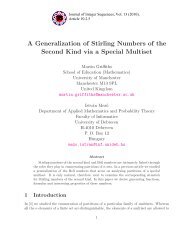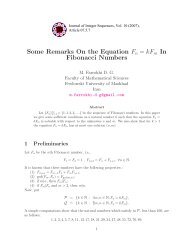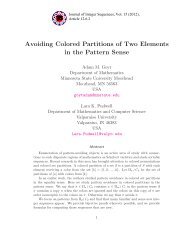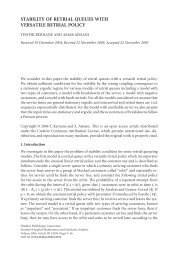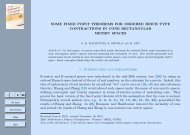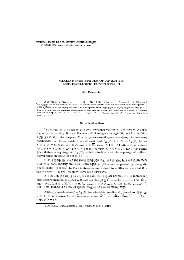THE MAXIMAL FUNCTION ON VARIABLE Lp SPACES
THE MAXIMAL FUNCTION ON VARIABLE Lp SPACES
THE MAXIMAL FUNCTION ON VARIABLE Lp SPACES
You also want an ePaper? Increase the reach of your titles
YUMPU automatically turns print PDFs into web optimized ePapers that Google loves.
The maximal function on variable L p spaces 225Very recently, Diening [4] has extended Theorem 1.1 to all of R n with theadditional assumption that p(x) is constant outside of a fixed ball. Further,Nekvinda [19] has shown that this hypothesis can be weakened as follows.Theorem 1.3 (Nekvinda). Let p: R n → [1, ∞) satisfy (1.2) and be suchthat 1 < p ∗ ≤ p ∗ < ∞. Suppose further that there is a constant p ∞ > 1 suchthat p(x) = p ∞ + φ(x), where there exists R > 0 such that φ(x) ≥ 0 if |x| > R,and β > 0 such that∫(1.3)φ(x)β 1/φ(x) dx < ∞.{x∈R n :φ(x)>0}Then the maximal operator is bounded on L p(x) (R n ).Remark 1.4 (Added in proof). We have learned that Nekvinda has improvedthis result by removing the requirement that φ be nonnegative.Note that together, conditions (1.2) and (1.3) imply φ(x) → 0 as |x| → ∞.Our first result is the following theorem; it is similar to Theorem 1.3 since itis for exponent functions p(x) of the same form (though φ need not be positive).Further, it gives a pointwise characterization of how quickly φ(x) must convergeto zero at infinity.Theorem 1.5. Given an open set Ω ⊂ R n , let p: Ω → [1, ∞) be such that1 < p ∗ ≤ p ∗ < ∞. Suppose that p(x) satisfies (1.2) and(1.4) |p(x) − p(y)| ≤Clog(e + |x|) ,x, y ∈ Ω, |y| ≥ |x|.Then the Hardy–Littlewood maximal operator is bounded on L p(x) (Ω).Condition (1.4) is the natural analogue of (1.2) at infinity. It implies thatthere is some number p ∞ such that p(x) → p ∞ as |x| → ∞, and this limit holdsuniformly in all directions. It is also necessary (in some sense) on R, as the nextexample shows.Theorem 1.6. Fix p ∞ , 1 < p ∞ < ∞, and let φ: [0, ∞) → [0, p ∞ − 1) besuch that φ(0) = 0, φ is decreasing on [1, ∞), φ(x) → 0 as x → ∞, and(1.5) lim φ(x) log(x) = ∞.x→∞Define the function p: R → [1, ∞) by{p∞ , x ≤ 0,p(x) =p ∞ − φ(x), x > 0;then the maximal operator is not bounded on L p(x) (R).
226 D. Cruz-Uribe, A. Fiorenza, and C.J. NeugebauerThe assumption in Theorem 1.5 that p ∗ < ∞ again holds automatically: itfollows from (1.4). However, the assumption that p ∗ > 1 is necessary, as thefollowing example shows.Theorem 1.7. Let Ω ⊂ R n be open, and let p: Ω → [1, ∞) be upper semicontinuous.If p ∗ = 1 then the maximal operator is not bounded on L p(x) (Ω).In passing, we note that an immediate application of Theorem 1.5 has beengiven by Diening [4]: he has shown that if ∂Ω is Lipschitz, and the maximaloperator is bounded on L p(x) (Ω), then C ∞ (Ω) is dense in W 1,p(x) (Ω).Unlike the case of the strong-type inequalities, we appear to be the first authorsto prove an analogue of the weak (p, p) inequality for the maximal operator.Our weak-type result is somewhat surprising, since it requires no continuity assumptionson p(x), and it is satisfied by unbounded functions. To state it, weneed a definition. Given a non-negative, locally integrable function u on R n , wesay that u ∈ RH ∞ if there exists a constant C such that for every ball B ,u(x) ≤ C|B|∫Bu(y) dy a.e. x ∈ B.Denote the smallest constant C such that this inequality holds by RH ∞ (u). TheRH ∞ condition is satisfied by a variety of functions u: for instance, if there existpositive constants A and B such that A ≤ u(x) ≤ B for all x. More generally,u ∈ RH ∞ if u(x) = |x| a , a > 0, or if there exists r > 0 such that u −r is in theMuckenhoupt class A 1 . For further information about RH ∞ , see Cruz-Uribe andNeugebauer [2].Theorem 1.8. Given an open set Ω, suppose the function p: Ω → [1, ∞)can be extended to R n in such a way that 1/p ∈ RH ∞ . Then for all f ∈ L p(x) (Ω)and t > 0,∫ ( ) p(y) |f(y)|(1.6) |{x ∈ Ω : Mf(x) > t}| ≤ Cdy.tRemark 1.9. Since p ∗ ≥ 1, 1/p is automatically in RH ∞ if p ∗ < ∞. But,as the above remarks show, this condition is not necessary.Remark 1.10. We can give an alternative version of Theorem 1.8 whichdoes not require extending p(x) to all of R n , but to do so we must replace theassumption that 1/p ∈ RH ∞ with the following condition: given any ball B ,|B ∩ Ω| > 0, and x ∈ B ∩ Ω,1/p(x) ≤ C ∫dy|B| p(y) .Note, however, that this condition need not hold if p(x) is constant, and so we donot recapture the classical result. We leave the details of the proof to the reader.ΩB∩Ω
228 D. Cruz-Uribe, A. Fiorenza, and C.J. NeugebauerLemma 2.2. Given a set G and two non-negative functions r(x) and s(x),suppose that for each x ∈ G,0 ≤ s(x) − r(x) ≤Then for every function f ,∫∫|f(x)| r(x) dx ≤ CGGClog(e + |x|) .∫|f(x)| s(x) dx +Proof. Let G α = {x ∈ G : |f(x)| ≥ α(x)}. Then∫GGα(x) r ∗(G) dx.∫∫|f(x)| r(x) dx = |f(x)| r(x) dx + |f(x)| r(x) dx,G α G\G αand we estimate each integral separately. First, since α(x) ≤ 1,∫∫∫|f(x)| r(x) dx ≤ α(x) r(x) dx ≤G\G α G\G αOn the other hand, if x ∈ G α , thenGα(x) r ∗(G) dx.|f(x)| r(x) = |f(x)| s(x) |f(x)| r(x)−s(x) ≤ |f(x)| s(x) α(x) −C/ log(e+|x|) ≤ C|f(x)| s(x) .The desired inequality now follows immediately.The next two lemmas generalize the key step in Diening’s proof of Theorem 1.1(see [3, Lemma 3.2]).Lemma 2.3. Given Ω and p as in the statement of Theorem 1.5, supposethat |f| p(x),Ω ≤ 1, and |f(x)| ≥ 1 or f(x) = 0, x ∈ Ω. Then for all x ∈ Ω,(2.1) Mf(x) p(x) ≤ CM(|f( · )| p( · )/p ∗)(x) p ∗+ Cα(x) p ∗,where α(x) = (e + |x|) −n .Proof. Without loss of generality, we may assume that f is non-negative. Fixx ∈ Ω, and fix a ball B of radius r > 0 containing x such that |B ∩ Ω| > 0.Let B Ω = B ∩ Ω. It will suffice to show that (2.1) holds with the left-hand sidereplaced by( ∫ ) p(x) 1f(y) dy ,|B| B Ωand with a constant independent of B . We will consider three cases.
The maximal function on variable L p spaces 229Case 1: r < |x|/4. Define ¯p(x) = p(x)/p ∗ . Then ¯p(x) ≥ 1, and (1.4) holdswith p replaced by ¯p. In particular, by our assumption on r , if y ∈ B Ω ,(2.2) 0 ≤ ¯p(y) − ¯p ∗ (B Ω ) ≤Clog(e + |y|) .Therefore, by Hölder’s inequality and by Lemma 2.2 with r(x) replaced bythe constant ¯p ∗ (B Ω ) and s(x) by ¯p(y), we have that( ∫ ) p(x) ( ∫) p(x)/¯p∗ (B 11Ω )f(y) dy ≤ f(y)¯p ∗(B Ω ) dy|B| B Ω|B| B Ω( ∫ C≤ f(y)¯p(y) dy + 1 ∫α(y)¯p ∗(B Ω ) dy|B| B Ω|B| B Ωsince r < |x|/4 and p(x)/¯p ∗ (B Ω ) ≤ p ∗ < ∞,( ∫) p(x)/¯p∗ (B CΩ )≤ f(y)¯p(y) dy + Cα(x)¯p ∗(B Ω )|B| B Ω( ∫) p(x)/¯p∗ (B 1Ω )≤ 2 p∗ C+ 2 p∗ Cα(x) p(x) .|B|B Ω f(y)¯p(y) dyIf |B| ≥ 1, then by Hölder’s inequality and since |f| p(x),Ω ≤ 1,) p(x)/¯p∗ (B Ω )∫( ∫) 1/p∗ (∫) 1/p∗11f(y)¯p(y) dy ≤ f(y) p(y) dy ≤ f(y) p(y) dy ≤ 1.|B| B Ω|B| B Ω B ΩHence, since p(x)/¯p ∗ (B Ω ) ≥ p ∗ and α(x) ≤ 1, we have that( ∫ ) p(x) ( ∫) p∗11f(y) dy ≤ C f(y)¯p(y) dy + Cα(x) p ∗|B| B Ω|B| B Ω≤ CM(f( · )¯p( · ) )(x) p ∗+ Cα(x) p ∗.If, on the other hand, |B| ≤ 1, then, again since |f| p(x),Ω ≤ 1,Therefore,∫(∫) 1/p∗ f(y)¯p(y) dy ≤ |B Ω | 1/p′ ∗f(y) p(y) dy ≤ 1.B Ω B Ω( ∫ ) p(x) 1f(y) dy ≤ C|B| −p(x)/¯p ∗(B Ω )(∫|B| B Ω≤ C|B| −p(x)/¯p ∗(B Ω )+p ∗( 1|B|) p(x)/¯p∗ (B Ω )f(y)¯p(y) dyB Ω∫B Ω f(y)¯p(y) dy+ Cα(x) p ∗) p∗+ Cα(x) p ∗.;
230 D. Cruz-Uribe, A. Fiorenza, and C.J. NeugebauerSince |B| ≤ 1, and sinceby Lemma 2.1,−p(x)/¯p ∗ (B Ω ) + p ∗ = ( p ∗ /p ∗ (B Ω ) )( p ∗ (B Ω ) − p(x) )≥ ( p ∗ /p ∗ (B Ω ) )( p ∗ (B Ω ) − p ∗ (B Ω ) ) ,( ∫) p∗1≤ C f(y)¯p(y) dy + Cα(x) p ∗≤ CM ( f( · )¯p( · )) (x) p ∗+ Cα(x) p ∗.|B| B ΩThis is precisely what we wanted to prove.Case 2: |x| ≤ 1 and r ≥ |x|/4. The proof is essentially the same as in theprevious case: since |x| ≤ 1, α(x) ≈ 1, so inequality (2.2) and the subsequentargument still hold.Case 3: |x| ≥ 1 and r ≥ |x|/4. Since f(x) ≥ 1, p ∗ ≥ 1 and |f| p(x),Ω ≤ 1,( ∫ ) p(x) (∫) p(x)1f(y) dy ≤ |B| −p(x) f(y) p(y) dy|B| B Ω B ΩThis completes the proof.≤ Cr −np(x) |f| p(x)p(x),Ω ≤ C|x|−np ∗≤ CM ( f( · )¯p( · )) (x) p ∗+ Cα(x) p ∗.≤ Cα(x) p ∗byDefinition 2.4. Given a function f on Ω, we define the Hardy operator HHf(x) = |B |x| (0)| −1 ∫B |x| (0)∩Ω|f(y)| dy.Lemma 2.5. Given Ω and p as in the statement of Theorem 1.5, supposethat |f| p(x),Ω ≤ 1, and |f(x)| ≤ 1, x ∈ Ω. Then for all x ∈ Ω,(2.3) Mf(x) p(x) ≤ CM ( |f( · )| p( · )/p ∗ ) (x) p ∗+ Cα(x) p ∗+ CHf(x) p(x) ,where α(x) = (e + |x|) −n .Proof. We may assume without loss of generality that f is non-negative. Weargue almost exactly as we did in the proof of Lemma 2.3. In that proof we onlyused the fact that f(x) ≥ 1 in Case 3, so it will suffice to fix x ∈ Ω, |x| ≥ 1, anda ball B containing x with radius r > |x|/4, and prove that( ∫ ) p(x) 1f(y) dy ≤ CM ( |f( · )| p( · )/p ) ∗(x) p ∗+ Cα(x) p ∗+ CHf(x) p(x) .|B| B Ω
Since p ∗ < ∞, we have thatsince r > |x|/4,The maximal function on variable L p spaces 231( ∫ ) p(x) ( ∫) p(x)11f(y) dy ≤ 2 p∗ f(y) dy|B| B Ω|B| B Ω ∩B |x| (0)( ∫p(x) 1+ 2 p∗ f(y) dy);|B|B Ω \B |x| (0)∫p(x) ( 1≤ C(|B |x| (0)| −1 |f(y)| dy)+ CB |x| (0)∩Ω|B|( ∫p(x) 1= CHf(x) p(x) + Cf(y) dy).|B|B Ω \B |x| (0)∫B Ω \B |x| (0)) p(x)f(y) dyTo estimate the last term, note that if y ∈ B Ω \ B |x| (0) then (2.2) holds andα(y) ≤ α(x), so the argument in Case 1 of the proof of Lemma 2.3 goes through.This shows that( ∫p(x) 1f(y) dy)≤ CM ( |f( · )| p( · )/p ) ∗(x) p ∗+ Cα(x) p ∗,|B| B Ω \B |x| (0)and this completes the proof.Lemma 2.6. If i(x) is a radial, increasing function, i ∗ > 1, and if |f(x)| ≤ 1,then∫Hf(y) i(y) dy ≤ C ( n, i(x) ) ∫ |f(y)| i(y) dy.Ω ΩProof. Without loss of generality we may assume that f is non-negative.Also, for clarity of notation, we extend f to all of R n by setting it equal to zeroon R n \ Ω.We first assume only that i ∗ ≥ 1. Recall that |B |x| (0)| = |B 1 (0)| |x| n . Let Sdenote the unit sphere in R n . Then by switching to polar coordinates and makinga change of variables, we get that∫Hf(x) i(x) =(|B 1 (0)| −1 |x| −n∫=(|B 1 (0)| −1 |x| −n∫=(|B 1 (0)| −1SS∫ 10B |x| (0)∫ |x|0) i(x)f(y) dy) i(x)f(rθ)r n−1 dr dθf(|x|rθ)r n−1 dr dθ) i(x)
The maximal function on variable L p spaces 233Remark 2.7. While Theorem 1.5 shows that we must have p ∗ < ∞ for thenorm inequality to be true in general, we do not need this assumption in restrictedcases. If f is a bounded, radial, decreasing function, then Mf(x) ≈ Hf(x), and soit follows from Lemma 2.6 that if p is a radial increasing function, ‖Mf‖ p(x),Ω ≤C‖f‖ p(x),Ω .Proof of Theorem 1.5. Without loss of generality we may assume that f isnon-negative. We first show there exists a constant C such that if |f| p(x),Ω ≤ 1,then |Mf| p(x),Ω ≤ C . Fix f , |f| p(x),Ω ≤ 1. Let f = f 1 + f 2 , wheref 1 (x) = f(x)χ {x:f(x)≥1} (x).Then for i = 1, 2, |f i | p(x),Ω ≤ 1. Since p ∗ < ∞,∫∫∫Mf(y) p(y) dy ≤ 2 p∗ Mf 1 (y) p(y) dy + 2 p∗ΩΩΩMf 2 (y) p(y) dy.We will show that each integral on the right-hand side is bounded by a constant.Since |f 2 (x)| ≤ 1, by Lemma 2.5, f 2 satisfies inequality (2.3). Therefore,if we integrate over Ω we get that∫∫Mf 2 (y) p(y) dy ≤ C M ( f 2 ( · ) p( · )/p ) ∫∗(y) p ∗dy + C α(y) p ∗dyΩΩΩ∫+ C Hf 2 (y) p(y) dy.ΩSince p ∗ > 1, M is bounded on L p ∗(Ω) and α(x) ∈ L p ∗(Ω), so∫∫∫≤ C f 2 (y) p(y) dy + C + C Hf 2 (y) p(y) dy ≤ C + C Hf 2 (y) p(y) dy.ΩΩGiven a function p, define its increasing, radial minorant i p to be the functioni p (x) =inf p(y).|y|≥|x|Clearly, i p is a radial, increasing function. Further, (1.4) implies that for all x ∈ Ω,0 ≤ p(x) − i p (x) ≤Clog(e + |x|) .Therefore, since f 2 (x) ≤ 1 and (i p ) ∗ = p ∗ , by Lemmas 2.6 and 2.2,∫∫∫Hf 2 (y) p(y) dy ≤ C Hf 2 (y) ip(y) dy ≤ C f 2 (y) ip(y) dyΩΩΩ∫∫≤ C f 2 (y) p(y) dy + C α(y) p ∗dy ≤ C.ΩΩΩ
234 D. Cruz-Uribe, A. Fiorenza, and C.J. NeugebauerHence, |Mf 2 | p(x),Ω ≤ C .A very similar argument using Lemma 2.3 shows that |Mf 1 | p(x),Ω ≤ C .Therefore, we have shown that if |f| p(x),Ω ≤ 1, then |Mf| p(x),Ω ≤ C . SinceC > 1, it follows that ∫(C −1 Mf(x) ) p(x)dx ≤ 1,which in turn implies thatΩ‖Mf‖ p(x),Ω ≤ C.To complete the proof we fix a function g ∈ L p(x) (Ω), and let f(x) =g(x)/‖g‖ p(x),Ω . Then ‖f‖ p(x),Ω ≤ 1, so |f| p(x),Ω ≤ 1. Hence,‖Mg‖ p(x),Ω = ‖g‖ p(x),Ω ‖Mf‖ p(x),Ω ≤ C‖g‖ p(x),Ω .3. Proofs of Theorems 1.6 and 1.7Proof of Theorem 1.6. Our proof is closely modeled on the construction givenby Pick and Růžička in [20].By inequality (1.5), we have thatwhich in turn implies thatlimx→∞(1 − p )∞log(x) = −∞,p(2x)limx→∞ x1−p ∞/p(2x) = 0.Therefore, we can form a sequence {c n } ∞ n=1 , c n+1 < 2c n ≤ −1, such that|c n | 1−p ∞/p(2|c n |) ≤ 2 −n .Let d n = 2c n < c n , and define the function f on R byf(x) =∞∑|c n | −1/p(|dn|) χ (dn ,c n )(x).n=1We claim that |f| p(x),R ≤ 1 and |Mf| p(x),R = ∞; it follows immediatelyfrom this that ‖f‖ p(x),R ≤ 1 and ‖Mf‖ p(x),R = ∞, so the maximal operator isnot bounded on L p(x) (R). First, we have that|f| p(x),R ==n=1∫ cn∞∑∞∑|c n | −p(x)/p(|dn|) dx =d n n=1∞∑∞∑|c n | 1−p ∞/p(|d n |) ≤ 2 −n = 1.n=1n=1∫ cnd n|c n | −p ∞/p(|d n |) dx
The maximal function on variable L p spaces 237where the supremum is taken over all balls containing x such that |B| ≤ N . Thesequence {M N f(x)} is increasing and converges to Mf(x) for each x ∈ Ω. Thus,by the monotone convergence theorem, for each t > 0,|{x ∈ Ω : Mf(x) > t}| = limN→∞ |{x ∈ Ω : M N f(x) > t}|.Therefore, it will suffice to prove (1.6) with M replaced by M N , and with aconstant independent of N .Fix t > 0 and let E N = {x ∈ Ω : M N f(x) > t}. Then for each x ∈ E N ,there exists a ball B x containing x, |B x | ≤ N , such that∫1|f(y)| dy > t.|B x | B x ∩ΩBy a weak variant of the Vitali covering lemma (cf. Stein [23, p. 9]), there existsa collection of disjoint balls, {B k }, contained in {B x : x ∈ E N }, and a constantC depending only on the dimension n, such that|E n | ≤ C ∑ k|B k |.Therefore, by Lemma 4.1,|E N | ≤ C ∑ k≤ ∑ k|B k | ≤ ∑ k( ∫ 1|B k | B k(∫|B k |B kdy) −11p(y) p ∗ (B k )dyp(y)) −1 ∫dyB kp(y)∫ ( ) p(y) |f(y)|dy;tB k ∩Ωsince p ∗ (B k ) −1 = (1/p) ∗ (B k ), by the definition of RH ∞ ,∫( ) p(y) ∫|f(y)|dy ≤ C( ) p(y) |f(y)|dy.≤ RH ∞ (1/p) ∑ kB k ∩ΩtΩtReferences[1] Acerbi, E., and G. Mingione: Regularity results for stationary electrorheological fluids.- Arch. Rational Mech. Anal. 164, 2002, 213–259.[2] Cruz-Uribe, D., and C.J. Neugebauer: The structure of the reverse Hölder classes. -Trans. Amer. Math. Soc. 347, 1995, 2941–2960.[3] Diening, L.: Maximal functions on generalized L p(x) spaces. - Math. Inequal. Appl. (toappear).[4] Diening, L.: Riesz potentials and Sobolev embeddings on generalized Lebesgue andSobolev spaces L p(x) and W k,p(x) . - University of Freiburg, preprint, 2002.


